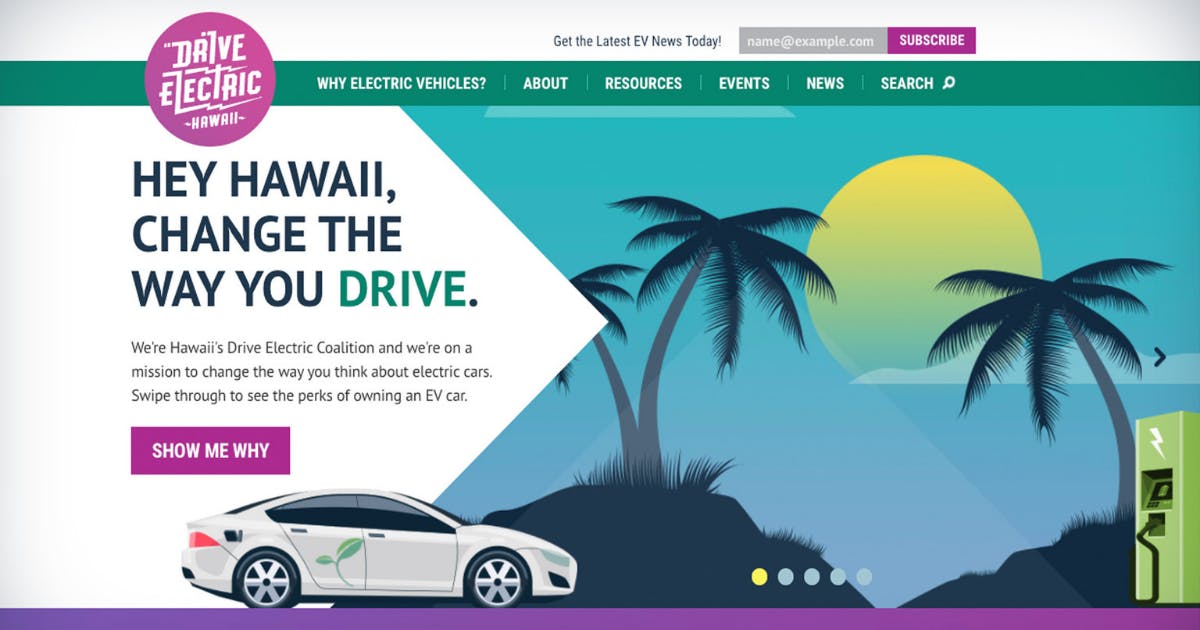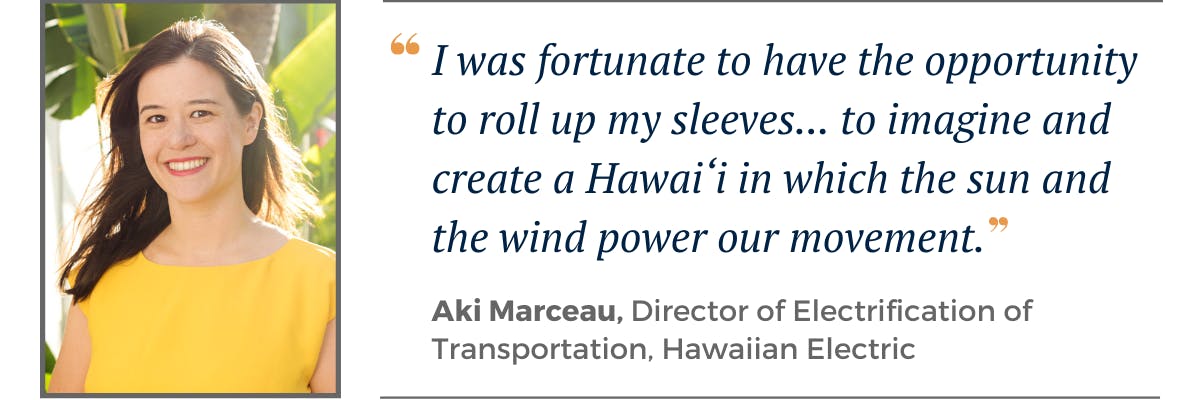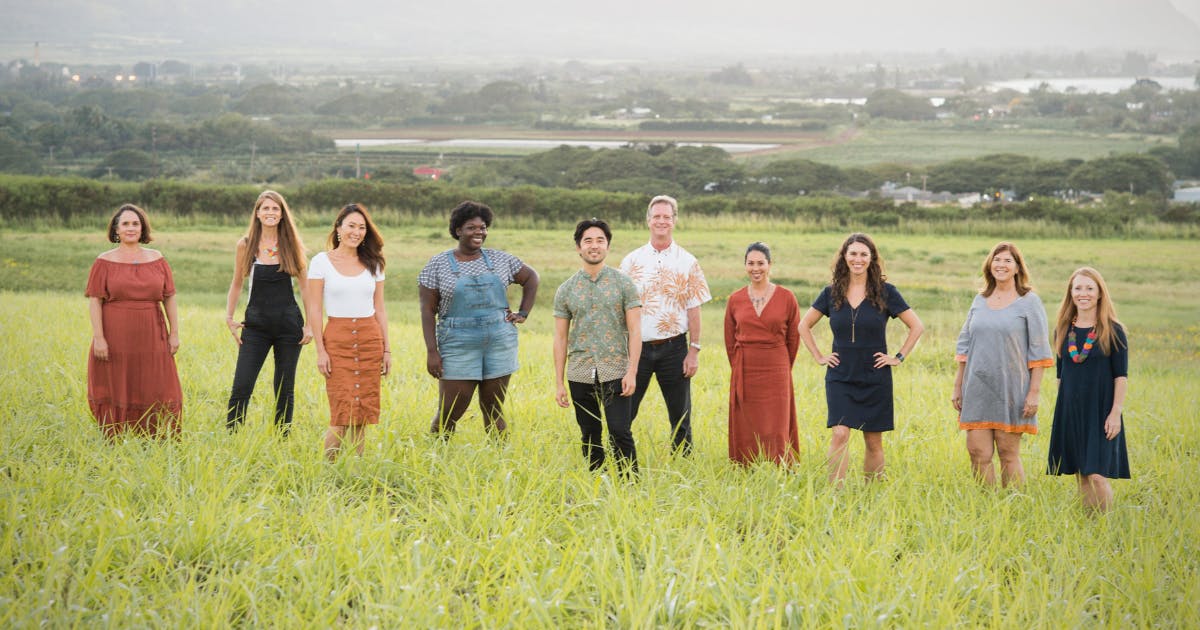A recent Civil Beat article reports that there are nearly 14,000 registered electric vehicles (EVs) in the state. While that represents only a little more than 1% of all of Hawai‘i’s passenger vehicles, Drive Electric Hawai‘i (DEH) is hoping to grow that number by changing the way residents think about electric cars.

Drive Electric Hawai‘i's website guides you through the perks of owning an electric car.
DEH was originally established in 2015 by a coalition of local government, nonprofit, and private sector stakeholders interested in increasing the awareness and adoption of EVs in Hawai‘i. Today, the coalition has grown to include 16 organizations, including Cohort VI Fellow Aki Marceau, Hawaiian Electric’s Director of Electrification of Transportation.
Aki answers our questions about her road to clean transportation, shares how her connections with the Omidyar Fellows program and Fellows have provided fuel along the way, and dispels a few myths that might make you shift gears in your thoughts about EVs.
Hawai‘i Leadership Forum (HLF): Tell us about Drive Electric Hawai‘i 2.0 – what are you doing and how do you hope to have impact?
Aki Marceau (AM): Drive Electric Hawai‘i is a network-led consortium of 16 signatories committed to advancing vehicle electrification in Hawai‘i through cross sector collaboration. Thanks to co-funding from Hawaiian Electric Industries Community Foundation and the support of AJ Halagao (Cohort II), through DEH 2.0 we will be working with Leslie Mullens (Cohort II) to reexamine our governance structure, identify guiding principles, and develop a 3-year strategic roadmap that will position us for greatest impact during this critical point of inflection.
With electric vehicle demand expected to increase over 10x in the next 10 years, the opportunity to work with and evolve Drive Electric Hawai‘i allows us to center our transition around community during this critical time when the clean energy and clean transportation economies begin to merge.
HLF: What was the spark that led to this journey you have been on? What personally motivated you to take on this work?
AM: I have transportation and environmentalism in my blood and my name. I’m also slightly wired like Leslie Knope from Parks and Rec. My Jii-chan and Ojichan (grandfather and uncle) owned a small bicycle shop called Wheel Works in western Japan, and my parents chose my first name, Eileen (my middle name is Aki), after Aileen Mioko Smith, known for her photojournalism of Minamata disease, the tragic human impacts of Japan’s industrial pollution. My parents are kind of intense like that.
As for a spark, after a yearlong stint as a park ranger in Alaska and student in Nepal, I was attracted to environmental work that focused less on conservation and more on the built environment. It was humans who were the problem after all.
I ended up landing my dream job after grad school planning large, high capacity electric vehicle that would run from Kapolei to Ala Moana (yes, THAT one). I quickly learned that it wasn’t so dreamy, and what separates successful and failed infrastructure projects is almost never technical, and almost always community acceptance. After that, I spent a few years learning from some of the best climate tech entrepreneurs on the planet, including Dawn Lippert (Cohort IV), and gained experience helping slow, legacy entities, like government and large institutions, innovate through new technologies, ideas, and policy.
The 2018 International Panel on Climate Change special report inspired me to pivot from advocacy to direct action. It stated that we have until 2030 to stop global warming. As an ENTP / Virgo / Strategic Achiever Activator Futurist (thank you OF and One Shared Future), I have a bias towards direct action, and I was fortunate to have the opportunity last year to roll up my sleeves alongside my DEH partners to imagine and create a Hawai‘i in which the sun and the wind power our movement.
HLF: How has your Omidyar Fellows experience and the Forum of Fellows contributed to this journey? How do you envision it might contribute in the future?
AM: Where to begin?! During my OF experience I gained new skills, but also completely transformed. I am greatly indebted to my Executive Coach, Phyllis Horner, who taught a lot of skills including how to identify my values and design my time and energy around those values. Other concepts I used daily are the four leadership competencies: manage self, energize others, diagnose the situation, and intervene skillfully. I love the idea of being strategic about when to raise and lower the heat. Learnings from the “Hero/Villain/ Victim” and “Designing an Alliance” exercises also pop up every day.
My transformation happened before and during my Individual Learning Excursion (ILE). I was on a journey to understand well-being and systems that create it. I naturally gravitated towards Bhutan which measures gross natural happiness, and even was able to meet the Prime Minister and give him an Aloha Plus pin during my time there.
The second part of my ILE involved 7 days in one of the monasteries that follows the teachings of Vietnamese Zen monk Thich Nhat Hanh. Quinn Vittum (Cohort VI) shared his experience at Plum Village in France which inspired me to visit Plum Village in Thailand. Many of the practitioners I met there were in their early 20s and had to leave Vietnam and go to Thailand to publicly practice, reminding me of my privilege. Something about the 4 a.m. meditations, total immersion in silence and Vietnamese (a language I do not speak), and his teachings rewired my brain. If you get a chance, read some of his poems. One of my favorite compilations is his love letters to the Earth.
HLF: What challenges have you faced? How did you overcome or learn from them?
AM: We are still in the early stages of DEH 2.0, but the need for revisioning stemmed from two areas of perceived improvement: 1. We couldn’t raise money because we didn’t have a fiscal sponsor or 501(c)(3) status. As a result, only the few members that were not government or nonprofit organizations could provide any financial resources. 2. We initially envisioned having a greater role in designing policy. However, because several of our signatories come from government, it was difficult to come to agreement on specific policy strategies.
We hope that this process will help us navigate through those specific challenges.
HLF: What would you consider a success you’ve experienced on this journey?
AM: I’m grateful for the foresight of those who predated me to create Drive Electric Hawai‘i in the first place. In particular, Shelee Kimura (Cohort V) , the Counties, State, Ulupono Initiative, Consumer Advocate, and others set the foundation for us to build off of. Josh Stanbro (Cohort IV) and Brian Kealoha (Cohort III) are both signatories. This allowed us to gain some early learnings to prepare us as we near this point of inflection.

HLF: What are some misconceptions about the electrification of transportation that you wish more people would understand?
AM: I have a few misconceptions I’d love to share.
- MYTH: EVs are only for the wealthy
FACT: A world in which it’s inconvenient or impossible to go to school, work, or the grocery store without owning a car is a world designed for the wealthy. We have to invest in convenient transit (including electric buses and trains!), connected and well-maintained sidewalks, and safe bike lanes. And the remaining vehicles should be electric. EVs specifically can be quite reasonable both in purchase and maintenance costs. Last year, I exchanged my 2007 Nissan Versa for a 2018 Nissan Leaf for less than $20,000, and at the time, there were many 2016 Leaf vehicles on the lot for less than $10,000. As a point of comparison, a used 2018 Toyota Tacoma, Hawai‘i’s most popular vehicle, is between $25,000-$40,000. - MYTH: Hawaiian Electric makes money on charging
FACT: Hawaiian Electric profits have been decoupled from its electricity sales for a decade, so we don’t make more money the more electricity we sell. What charging will do, however, is spread out the unit cost of running the grid across more kWh, thereby putting downward pressure on rates, even for those who don’t own an EV. We’re creating price signals to encourage charging when renewable energy is abundant. - MYTH: Hawaiian Electric and Tesla are competing for fast chargers
FACT: We work closely with Tesla and other EV infrastructure providers to ensure they have the power they need to offer charging to their customers. Hawaiian Electric’s chargers are technology agnostic and can be used with adapters, while Tesla’s naturally serve Tesla vehicles. There are a few projects in the pipeline that we are very excited about. If they are successful, we are all successful.
HLF: Do you have any other clean transportation projects that you are working on?
AM:
- Hawaiian Electric offers a network of public fast chargers across on O‘ahu, Maui, Moloka‘i and Hawai‘i Island, and we are planning to submit an application later this year to expand our network. I’ve been lucky to work with Fellows like Giorgio Calderone (Cohort II) when looking for sites for these locations.
- We also are awaiting a decision from the Public Utilities Commission that would allow us to pilot “make ready infrastructure” for fleet, apartment/condo, and hub charging. Infrastructure can be over 50% of the total cost of transitioning, so we hope that this pilot will help us help our business partners to accelerate this transition. If all goes well, you’ll be able to bundle make ready infrastructure with rebates from Hawai‘i Energy (led by Brian Kealoha & Stephany Vaioletti [both of Cohort III]).
- Don’t forget to sign up for Blue Planet Foundation’s (Jeff Mikulina [Cohort VI]) Hawai‘i Bike Challenge from May 1-31, 2021. I’m on Team Spoked, and I’m pretty spoked about it.
HLF: Any final thoughts on ways people can get involved?
AM: Yes! For any commercial real estate focused business owners thinking about converting your fleets, I’d love to have a virtual coffee with you to learn more about your electrification plans. Please reach out by contacting goev@hawaiianelectric.com with subject: Commercial EV Opportunities.
Cohort IV Fellow Dawn Lippert is the CEO of Elemental Excelerator, a nonprofit that supports entrepreneurs working to redesign the systems at the root of climate change. They recently released their 5 year strategy to scale climate and social equity solutions.
